Inspired from the latest post, https://authorspromotion.wordpress.com/2015/03/19/the-myth-of-the-professional-writer/ I thought is a good day to post something else.For many of my readers who don’t know too much about me, I have to tell you that I am back in my country now, Romania.Probably for many of us the previous months meant just working hard so it’s time now to think about a little break, traveling and explore new countries and new culture.Why not Romania?
https://www.smore.com/jej0v-romanian-easter-holidays?embed=1
Dracula – Beyond the Legend
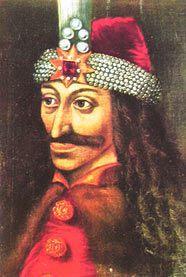
Tracking Dracula
» Places to explore
» Upcoming Dracula themed tours
Dracula – Beyond the Legend
» Bram Stoker’s inspiration
» Who was Vlad Dracula ?
“ We Draculs have a right to be proud…
I am the last of my kind ”
– Dracula, from Bram Stoker’s Dracula
Some say that Transylvania sits on one of Earth’s strongest magnetic fields and its people have extra-sensory perception. Vampires are believed to hang around crossroads on St. George’s Day, April 23, and the eve of St. Andrew, November 29. The area is also home to Bram Stoker’s Dracula, and it’s easy to get caught up in the tale while driving along winding roads through dense, dark, ancient forests and over mountain passes.
Dracula is literally translated in Gaelic asDrac Ullah meaning bad blood.
Tales of the supernatural had been circulating in Romanian folklore for centuries when Irish writer Bram Stoker picked up the thread and spun it into a golden tale of ghoulishness that has never been out of print since its first publication in 1897. To research his immortal tale, Stoker immersed himself in the history, lore and legends of Transylvania, which he called a “whirlpool for the imagination.”
Bram Stoker’s Dracula novel was published in Romanian for the first time in 1990.Count Dracula, a fictional character in the Dracula novel, was inspired by one of the best-known figures of Romanian history, Vlad Dracula, nicknamed Vlad Tepes (Vlad the Impaler), who was the ruler of Walachia at various times from 1456-1462. Born in 1431 in Sighisoara, he resided all his adult life in Walachia, except for periods of imprisonment at Pest and Visegrad (in Hungary). For more information about Bram Stocker’s Dracula Novel please visit www.literature.org/authors/stoker-bram/dracula/
Travel Journal: “In the Footsteps of Dracula.”Although he never traveled to Romania, Stoker crammed his book with descriptions of many real locations that can still be visited in
present-day Romania. They include
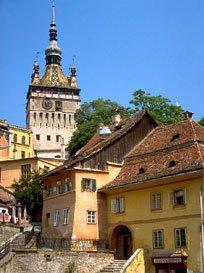
important historical places associated with
Vlad Tepes, such as the 14th century town of
Sighisoara where you can visit the house in
which Vlad was born (now hosting a restaurant
and a small museum of medieval weapons).
Other Dracula sites include: the Old Princely Court (Palatul Curtea Veche) in Bucharest,Snagov Monastery, where, according to legend, Vlad’s remains were buried; the ruins of thePoenari Fortress (considered to be the authentic Dracula’s Castle); the village of Arefuwhere Dracula legends are still told, the city ofBrasov where Vlad led raids against the Saxons merchants, and, of course, Bran Castle.
A Halloween Themed InfographicSome tours also cover the folkloric aspects of the fictional Dracula. For instance, visitors can eat the exact meal Jonathan Harker ate at The Golden Crown in Bistrita and sleep at Castle Dracula Hotel, built no so long ago on the Borgo Pass at the approximate site of the fictional Count’s castle.

Places to explore
- Bucharest (Old Princely Court)
- Snagov Monastery
- Targoviste
- Poenari Fortress
- Arefu Village
- Brasov
- Bran (Dracula’s) Castle
- Sighisoara
- Bistrita (Borgo Pass)
Known for its wide, tree-lined boulevards, glorious Belle Époque buildings and a reputation for the high life (which in the 1900s earned its nickname of “Little Paris”), Bucharest, Romania’s largest city and capital, is today a bustling metropolis. Bucharest is laden with historical charm – from the streets of the Old City Center, which are slowly being restored, to the grand architecture of the Royal Palace and the lush green of Cismigiu Park. The city also claims a large number of museums, art galleries, exquisite Orthodox churches and unique architectural sites (find out more about Bucharest).Old Princely Court
(Palatul Curtea Veche)
Address: Strada Franceza 25-31
Telephone: (21) 314.03.75
Museum open: Tue. – Sun. 10:00 a.m. – 6:00 p.m.; Closed Mon.
Admission charge
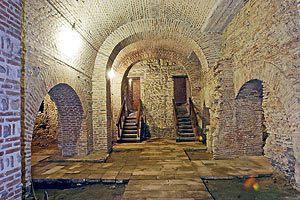
The Old Court Museum was established in 1972 when an archaeological dig revealed the remains of the fortress, along with Dacian pottery and Roman coins, evidence of Bucharest’s earliest inhabitants. The oldest document attesting to the city’s origin under the name of Bucuresti was discovered here. It was issued on September 20, 1459 and signed by Prince Vlad Tepes.
Next to the palace stands the Old Court Church (Biserica Curtea Veche), dating from 1559 and considered the oldest in Bucharest. For two centuries, the church served as coronation ground for Romanian princes. Some of the original 16th century frescoes have been preserved.
Snagov Monastery
Where: 25 miles north of Bucharest
Nearest train station: Bucuresti Nord
Nearest bus stop: Snagov / Silistea Snagovului
In 1458 – more than one hundred years after the church was built (1364) – Romanian prince Vlad Tepes (Vlad the Impaler) added thick defending walls
and a dungeon. A plaque on the floor inside the church marks the grave with
the presumed remains of the world-known count.
The monastery is located on an island on lake Snagov, and can be accessed
on a pedestrian bridge or by boat.
Targoviste – Princely Court
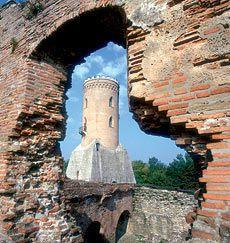
Where: 64 miles northwest of Bucharest
Nearest train station: Targoviste
Address: Calea Domneasca 181
Telephone: (245) 613.946
Open: Tue. – Sun. 9:00 a.m. – 7 p.m.;
Closed Mon.
Admission fee
www.CurteaDomneascaTargoviste.ro/
In Targoviste, tour the 14th centuryPrincely Court and Chindiei Watchtower(Turnul Chindiei). The Princely Court served as the capital of Walachia, where Vlad ruled. It was here that the Prince impaled a great many disloyal court members (the boyars) after inviting them to a celebratory feast. Chindiei Watchtower now houses an exhibition illustrating Vlad’s life.

Poenari Fortress
(Cetatea Poenari)
Location: Valachia – Southern-Centre Romania
Where: 108 miles northwest of Bucharest
Nearby large town: Curtea de Arges (15 miles north)
Nearest train station: Curtea de Arges
Nearest bus stop: Arefu
Web: www.CetateaPoenari.ro
Open: 9:00 am – 6:00 pm (summer time)
Admission charge: adults 5 lei ($1.75)
The ruins of Poienari Fortress stand high on a cliff overlooking the Arges River, at the foothills of the Carpathian Mountains. Built at the beginning of the 13th century by the first Walachian rulers, the castle changed names and residents a few times over the decades; eventually, it was abandoned and left in ruins.
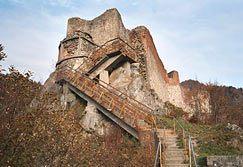
You will need stamina to climb the 1,462 steps to reach the castle ruins, perched high above the surrounding area like an eagle’s nest.
Arefu
Where: 104 miles northwest of Bucharest / 11 miles north of Curtea de Arges
Note: access by car only
Next visit Arefu, where many of the villagers trace their ancestry back to the loyal minions of Vlad Tepes himself (in the movies, these are the ones who are always busy loading up Dracula’s coffins with Transylvanian earth). Legend has it that when the Turks attacked and took over the Poenari Castle in 1462, it was the villagers of Arefu who helped Vlad escape. Spend the night with the locals camping around a fire and listening to centuries-old folk tales. Homestays and B&Bs are available in Arefu and nearby villages.
Brasov
Where: 100 north of Bucharest
Nearest train station: Brasov
Fringed by the peaks of the Southern Carpathian Mountains and resplendent with gothic, baroque and renaissance architecture, as well as a wealth of historical attractions, Brasov is one of the most visited places in Romania.
(find out more about Brasov)

Bran Castle
Where: 84 miles north of Bucharest / 16 miles southwest of BrasovAccess: car, train to Brasov, and bus from Brasov to Bran
www.RomaniaTourism.com/Castles-Fortresses.html#Bran
The countryside is the heart and soul of Romania, where peasant culture remains a strong force and medieval life prevails, as it does nowhere else in Europe. A young American couple, researching ancient traditional villages in Europe for post-graduate studies, recently moved in with a host family in Northern Romania in order to document a culture unique in the world.
Filed under: Romanian places to go, Uncategorized Tagged: best places to go in Romania, discover Romania, Grand Hotel Perla Ciucasului, Romanian holidays







